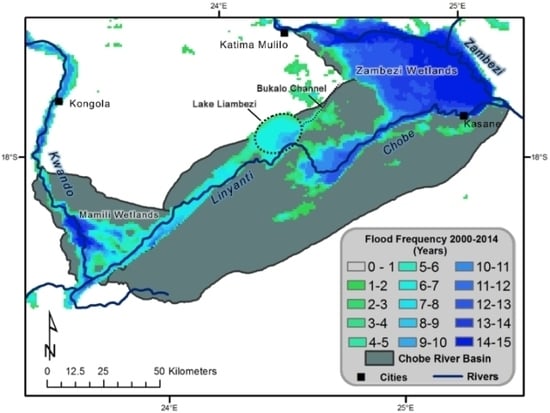Thermal Imagery-Derived Surface Inundation Modeling to Assess Flood Risk in a Flood-Pulsed Savannah Watershed in Botswana and Namibia
Abstract
:1. Introduction
- (1)
- Can thermal imagery be utilized successfully to determine the seasonal and inter-annual patterns of inundation in the Chobe River Basin and how have they changed over the past 15 years?
- (2)
- What are the driving forces that control the magnitude of flooding of the Chobe River, do different variables have more of an impact on the flooding magnitude than others and how do these variables differ between years that experience average flooding and years with unusual (high or low) flooding magnitude?
- (3)
- Where in the Chobe River basin are large populations of people most susceptible to high magnitude floods?
2. Materials and Methods
2.1. Study Area
2.2. Materials
2.2.1. Thermal Imagery (Land Surface Temperature)
2.2.2. Discharge and Stage Data
2.2.3. Precipitation
2.2.4. Population and Ancillary Data
2.3. Methods
2.3.1. MODIS Pre-Processing and Image Differencing
2.3.2. Image Threshold Segmentation
2.3.3. Inundation Mapping Validation
2.3.4. Regression Analysis of Flood, Discharge and Precipitation Patterns
2.3.5. At-Risk Population Analysis
3. Results
3.1. Regional Inundation Duration
3.2. Inundation Duration 2000–2014
3.3. Typical Seasonal Inundation Dynamics
3.4. Regression Analysis of Flood and Precipitation Patterns
Chobe River Basin Statistics
3.5. Population-Flood Risk Mapping
4. Discussion
5. Conclusions
Acknowledgments
Author Contributions
Conflicts of Interest
References
- Bogardi, J. Two Billion Will Be in Flood Path by 2050. Available online: http://archive.unu.edu/update/archive/issue322.htm (accessed on 25 September 2014).
- Intergovernmental Panel on Climate Change (IPCC). Managing the Risks of Extreme Events and Disasters to Advance Climate Change Adaptation; A Special Report of Working Groups I and II of the Intergovernmental Panel on Climate Change; Field, C.B., Barros, V.R., Stocker, T.F., Qin, D., Dokken, D.J., Ebi, K.L., Mastrandrea, M.D., Mach, K.J., Plattner, G.K., Allen, S.K., et al., Eds.; Cambridge University Press: Cambridge, UK, 2012. [Google Scholar]
- Hui, F.M.; Xu, B.; Huang, H.B.; Yu, Q.; Gong, P. Modelling spatial-temporal change of Poyang Lake using multitemporal Landsat imagery. Int. J. Remote Sens. 2008, 29, 5767–5784. [Google Scholar] [CrossRef]
- Ramsey, E.; Lu, Z.; Suzuoki, Y.; Rangoonwala, A.; Werle, D. Monitoring duration and extent of storm-surge and flooding in western coastal Louisiana Marshes With ENVISAT ASAR data. IEEE J. Sel. Top. Appl. Earth Observ. Remote Sens. 2011, 4, 387–399. [Google Scholar] [CrossRef]
- McCarthy, J.M.; Gumbricht, T.; McCarthy, T.; Frost, P.; Wessels, K.; Seidel, F. Flooding patterns of the Okavango wetland in Botswana between 1972 and 2000. Ambio 2003, 32, 453–457. [Google Scholar] [CrossRef] [PubMed]
- Sakamoto, T.; Van Nguyen, N.; Kotera, A.; Ohno, H.; Ishitsuka, N.; Yokozawa, M. Detecting temporal changes in the extent of annual flooding within the Cambodia and the Vietnamese Mekong Delta from MODIS time-series imagery. Remote Sens. Environ. 2007, 109, 295–313. [Google Scholar] [CrossRef]
- Khan, S.I.; Hong, Y.; Wang, J.; Yilmaz, K.K.; Gourley, J.J.; Adler, R.F.; Irwin, D. Satellite remote sensing and hydrologic modeling for flood inundation mapping in Lake Victoria basin: Implications for hydrologic prediction in ungauged basins. IEEE Trans. Geosci. Remote Sens. 2011, 49, 85–95. [Google Scholar] [CrossRef]
- Handisyde, N.; Lacalle, D.S.; Arranz, S.; Ross, L.G. Modelling the flood cycle, aquaculture development potential and risk using MODIS data: A case study for the floodplain of the Rio Paraná, Argentina. Aquaculture 2014, 422, 18–24. [Google Scholar] [CrossRef]
- Pricope, N.G. Variable-source flood pulsing in a semi-arid transboundary watershed: The Chobe River, Botswana and Namibia. Environ. Monit. Assess. 2013, 185, 1883–1906. [Google Scholar] [CrossRef] [PubMed]
- Long, S.; Fatoyinbo, T.E.; Policelli, F. Flood extent mapping for Namibia using change detection and thresholding with SAR. Environ. Res. Lett. 2014, 9, 1–9. [Google Scholar] [CrossRef]
- Huang, C.; Peng, Y.; Lang, M.; Yeo, I.-Y.; McCarty, G. Wetland inundation mapping and change monitoring using Landsat and airborne LiDAR data. Remote Sens. Environ. 2014, 141, 231–242. [Google Scholar] [CrossRef]
- Ward, D.P.; Petty, A.; Setterfield, S.A.; Douglas, M.M.; Ferdinands, K.; Hamilton, S.K.; Phinn, S. Floodplain inundation and vegetation dynamics in the Alligator Rivers region (Kakadu) of northern Australia assessed using optical and radar remote sensing. Remote Sens. Environ. 2014, 147, 43–55. [Google Scholar] [CrossRef]
- Gao, B.C. NDWI—A normalized difference water index for remote sensing of vegetation liquid water from space. Remote Sens. Environ. 1996, 58, 257–266. [Google Scholar] [CrossRef]
- Xu, H.Q. Modification of normalised difference water index (NDWI) to enhance open water features in remotely sensed imagery. Int. J. Remote Sens. 2006, 27, 3025–3033. [Google Scholar] [CrossRef]
- Pricope, N.G.; Binford, M.W. A spatio-temporal analysis of fire recurrence and extent for semi-arid savanna ecosystems in southern Africa using moderate-resolution satellite imagery. J. Environ. Manag. 2012, 100, 72–85. [Google Scholar] [CrossRef] [PubMed]
- Ordoyne, C.; Friedl, M.A. Using MODIS data to characterize seasonal inundation patterns in the Florida Everglades. Remote Sens. Environ. 2008, 11, 4107–4119. [Google Scholar] [CrossRef]
- Pekel, J.-F.; Vancutsem, C.; Bastin, L.; Clerici, M.; Vanbogaert, E.; Bartholomé, E.; Defourny, P. A near real-time water surface detection method based on HSV transformation of MODIS multi-spectral time series data Remote Sens. Environ. 2014, 140, 704–716. [Google Scholar]
- Franck, R.; Prinz, B.; Spitzer, H. Supporting land-use mapping by using multitemporal thermal infrared imagery in conjunction with a simple diurnal temperature model. In Proceedings of the Fourth International Airborne Remote Sensing Conference and Exhibition/21st Canadian Symposium on Remote Sensing, Ottawa, ON, Canada, 21–24 June 1999.
- Sosnowski, A.; Ghoneim, E.; Burke, J.J.; Hines, E.; Halls, J. Remote regions, remote data: A spatial investigation of precipitation, dynamic land covers, and conflict in the Sudd wetland of South Sudan. Appl. Geogr. 2016, 69, 51–64. [Google Scholar] [CrossRef]
- Veroustraete, F.; Li, Q.; Verstraeten, W.W.; Chen, X.; Li, J.; Liu, T.; Dong, Q.H.; Willems, P. The AMSL LST algorithm validated for the Xinjiang Autonomous Region in China. Int. J. Remote Sens. 2012, 33, 3886–3906. [Google Scholar] [CrossRef]
- Leblanc, M.; Lemoalle, J.; Bader, J.C.; Tweed, S.; Mofor, L. Thermal remote sensing of water under flooded vegetation: New observations of inundation patterns for the “Small” Lake Chad. J. Hydrol. 2011, 404, 87–98. [Google Scholar] [CrossRef]
- Chen, Y.; Huang, C.; Ticehurst, C.; Merrin, L.; Thew, P. An evaluation of MODIS daily and 8-day composite products for floodplain and wetland inundation mapping. Wetlands 2013, 33, 823–835. [Google Scholar] [CrossRef]
- Scudder, T. Need and justification for maintaining transboundary flood regimes: The Africa case. Nat. Resour. J. 1991, 31, 75–107. [Google Scholar]
- Inambao, C. Namibia: Caprivi Floods Reach Historic Mark. Available online: http://reliefweb.int/report/namibia/namibia-caprivi-floods-reach-historic-mark (accesed on 3 July 2013).
- Wolski, P.; Stone, D.; Tadross, M.; Wehner, M.; Hewitson, B. Attribution of floods in the Okavango basin, southern Africa. J. Hydrol. 2014, 511, 350–358. [Google Scholar] [CrossRef]
- Kachingo, F.; School Teacher, Etomba, Namibia. Personal communication, 2014.
- Fraser, C. Africa’s Ambitious Experiment to Preserve Threatened Wildlife; Yale Environmental e360, Yale School of Forestry and Environmental Studies: New Haven, CT, USA, 2012; Volume 14, pp. 1–13. [Google Scholar]
- Gaughan, A.E.; Waylen, P.R. Spatial and temporal precipitation variability in the Okavango–Kwando–Zambezi catchment, southern Africa. J. Arid Environ. 2012, 82, 9–30. [Google Scholar]
- Mwilima, E.S.; MET, KAZA, Windhoek, Namibia. Personal communication, 2014.
- Beilfuss, R. A Risky Climate for Southern African Hydro: Assessing Hydrological Risks and Consequences for Zambezi River Basin Dams; International Rivers: Berkeley, CA, USA, 2012. [Google Scholar]
- Giannini, A.; Biasutti, M.; Held, I.M.; Sobel, A.H. A global perspective on African climate. Clim. Chang. 2008, 90, 359–383. [Google Scholar] [CrossRef]
- Wan, Z. MODIS Land-Surface Temperature Algorithm Theoretical Basis Document (LST ATBD); Version 3.3; NASA Documents; Institute for Computational Earth System Science, University of California: Santa Barbara, CA, USA, 1999. Available online: http://modis.gsfc.nasa.gov/atbd/atbd_mod11.pdf 26 (accessed on 18 January 2015).
- Wan, Z. MODIS Land Surface Temperature Products Users’ Guide; Institute for Computational Earth System Science, University of California: Santa Barbara, CA, USA, 2006; Available online: http://www. icess. ucsb. edu/modis/LstUsrGuide/usrguide.html (accessed on 26 January 2015).
- Curtarelli, M.P.; Rennó, C.D.; Alcântara, E.H. Evaluation of the Tropical Rainfall Measuring Mission 3B43 product over an inland area in Brazil and the effects of satellite boost on rainfall estimates. J. Appl. Remote Sens. 2014, 8, 083589. [Google Scholar] [CrossRef]
- Adeyewa, Z.D.; Nakamura, K. Validation of TRMM radar rainfall data over major climatic regions in Africa. J. Appl. Meteorol. 2003, 42, 331–337. [Google Scholar] [CrossRef]
- Linard, C.; Gilbert, M.; Snow, R.W.; Noor, A.M.; Tatem, A.J. Population distribution, settlement patterns and accessibility across Africa in 2010. PLoS ONE 2012, 7, e31743. [Google Scholar] [CrossRef] [PubMed]
- White, D.A. The MODIS Conversion Toolkit (MCTK) User’s Guide. ITT Visual Information Solutions. Available online: http://nsidc.org/data/modis/tools.html (accessed on 20 April 2014).
- Otsu, N. A threshold selection method from gray-level histograms. Automatica 1975, 11, 23–27. [Google Scholar]
- Shu, Y.; Li, J.; Yousif, H.; Gomes, G. Dark-spot detection from SAR intensity imagery with spatial density thresholding for oil-spill monitoring. Remote Sens. Environ. 2010, 114, 2026–2035. [Google Scholar] [CrossRef]
- Dobriyal, P.; Qureshi, A.; Badola, R.; Hussain, S.A. A review of the methods available for estimating soil moisture and its implications for water resource management. J. Hydrol. 2012, 458–459, 110–117. [Google Scholar] [CrossRef]
- Mediero, L.; Kjeldsen, T.R. Regional flood hydrology in a semi-arid catchment using a GLS regression model. J. Hydrol. 2014, 514, 158–171. [Google Scholar] [CrossRef]
- Cohen, R.A. Introducing the GLMSELECT procedure for model selection. In Proceedings of the 31st Annual SAS Users Group International Conference, Cary, NC, USA, 26–29 March 2006; pp. 207–231.
- Montanyane, E.; The Department of Water Affairs, Kasane, Botswana. Personal communication, 2014.
- High Resolution, Contemporary Data on Human Population Distributions, Namibia; Worldpop Africa Dataset; GeoData Institute, University of Southampton: UK, 2014; Available online: http://www.worldpop.org.uk/data/summary/?contselect=Africa&countselect=Namibia&typeselect=Population (accessed on 12 February 2015).
- Integrated Regional Information Networks (IRIN). Namibia/Zambia: Flood Insecurity Looms as Floods Swallow Crops, 2009. Available online: http://www.irinnews.org/report/83623/namibia-zambia-flood-in-security-looms-as-floods-swallow-crops (accessed on 30 March 2014).
- Gumbricht, T.; Wolski, P.; Frost, P.; McCarthy, T.S. Forecasting the spatial extent of the annual flood in the Okavango Delta, Botswana. J. Hydrol. 2004, 290, 178–191. [Google Scholar] [CrossRef]
- Famine Early Warning Systems Network (FEWS NET). Southern Africa Special Report: 2014/2015 El Nino Event. Available online: http://reliefweb.int/report/mozambique/southern-africa-special-report-201415-el-ni-o-event-july-2014 (accessed on 31 March 2015).
- Ogilvie, A.; Belaud, G.; Delenne, C.; Bailly, J.-S.; Bader, J.-C.; Oleksiak, A.; Ferry, L.; Martin, D. Decadal monitoring of the Niger Inner Delta flood dynamics using MODIS optical data. J. Hydrol. 2015, 523, 368–383. [Google Scholar] [CrossRef]
- Bosch, N. Flooding Caprivi Namibia. Available online: http://www.caprivi.biz/flooding.html (accessed on 29 March 2015).
- Intergovernmental Panel on Climate Change (IPCC). Climate Change 2014: Impacts, Adaptation, and Vulnerability. Part A: Global and Sectoral Aspects; Contribution of Working Group II to the Fifth Assessment Report of the Intergovernmental Panel on Climate Change; Field, C.B., Barros, V.R., Dokken, D.J., Mach, K.J., Mastrandrea, M.D., Bilir, T.E., Chatterjee, M., Ebi, K.L., Estrada, Y.O., Genova, R.C., et al., Eds.; Cambridge University Press: Cambridge, UK, 2014. [Google Scholar]
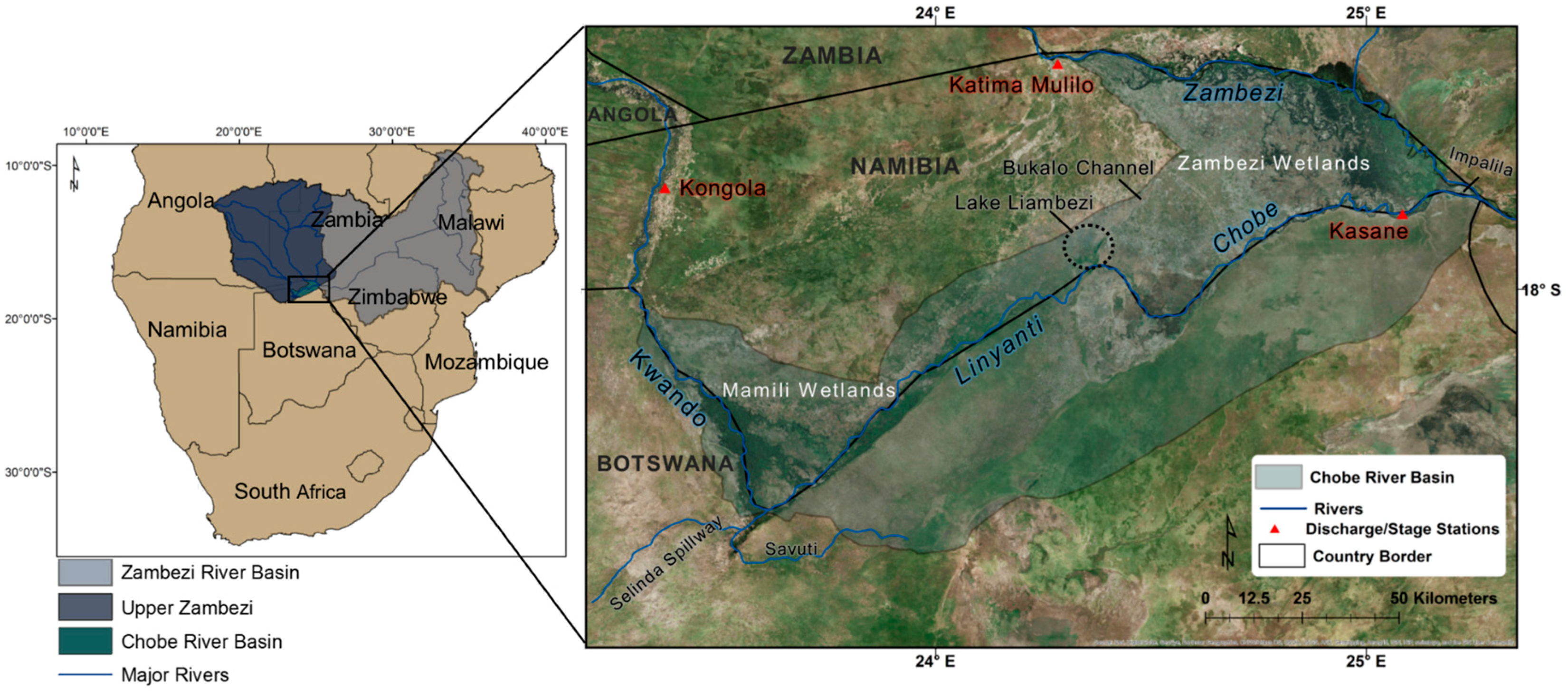



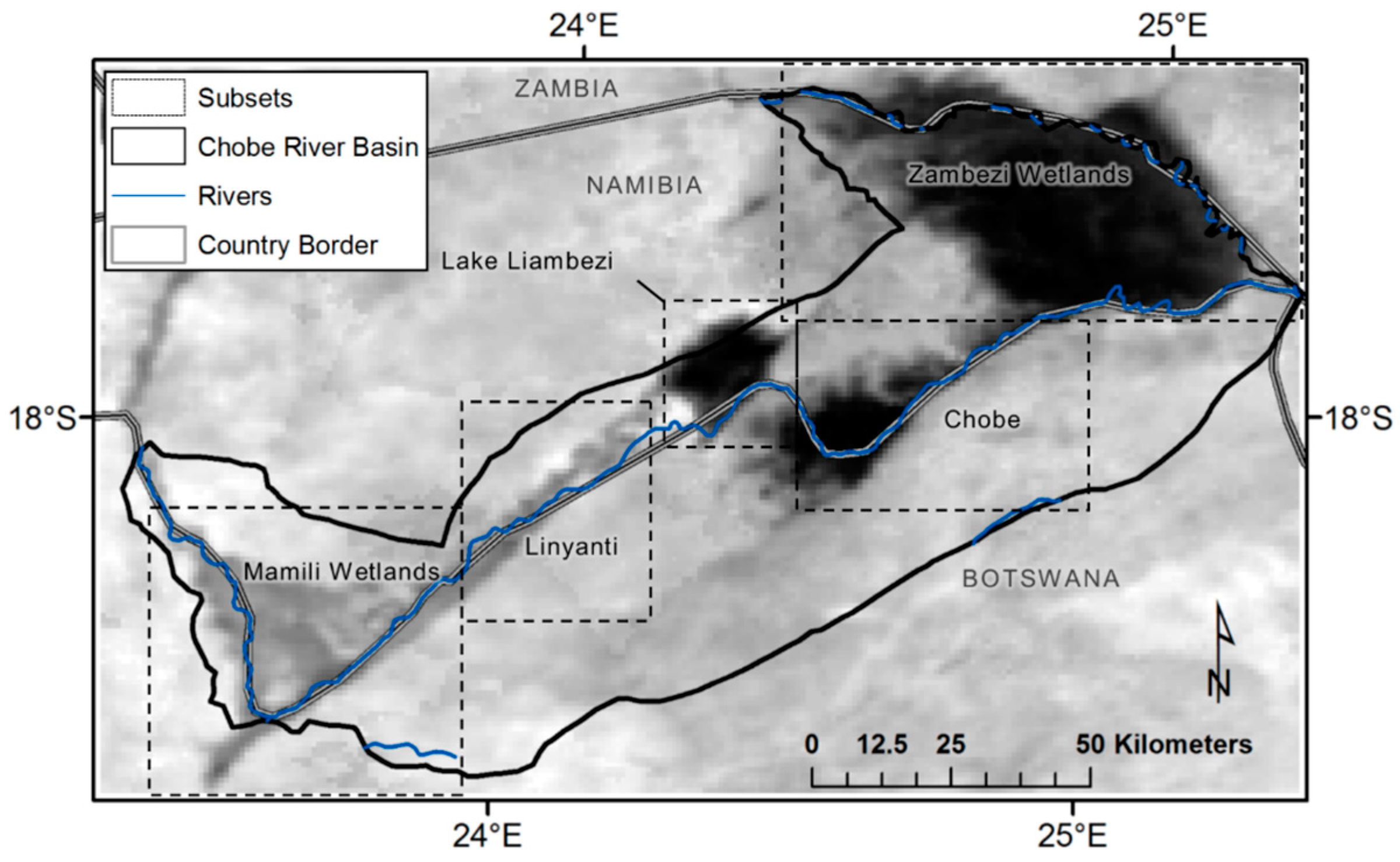
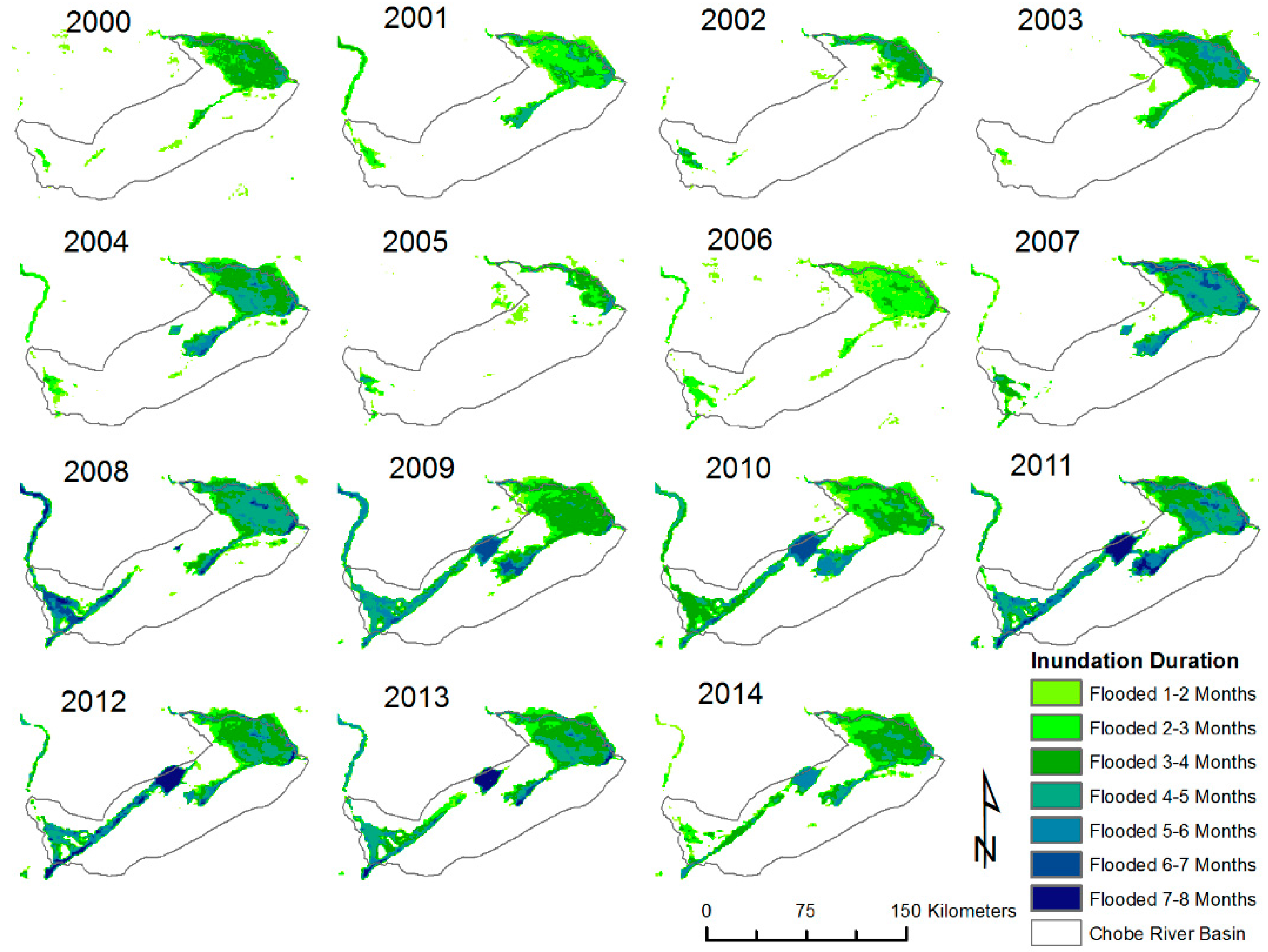

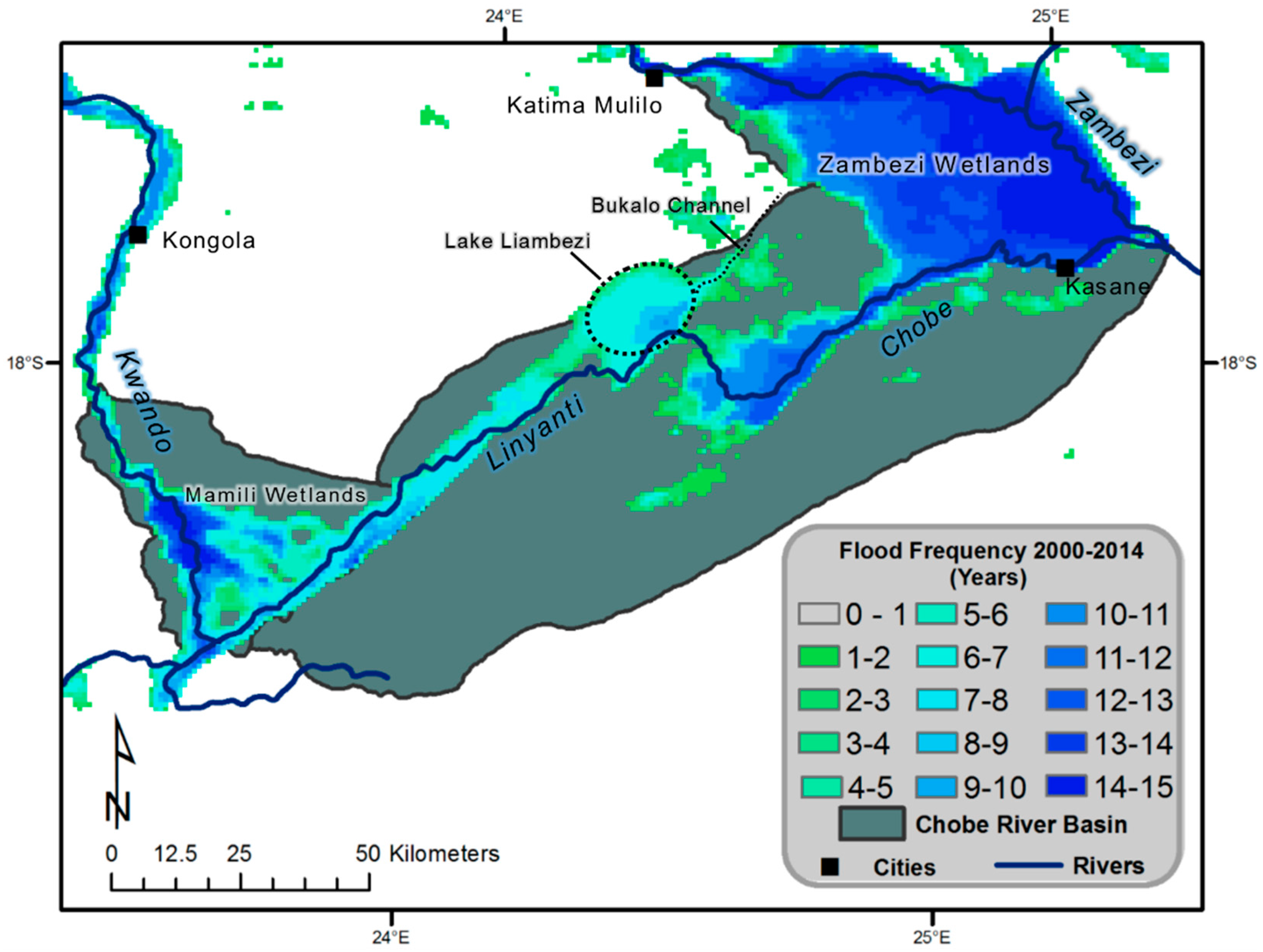
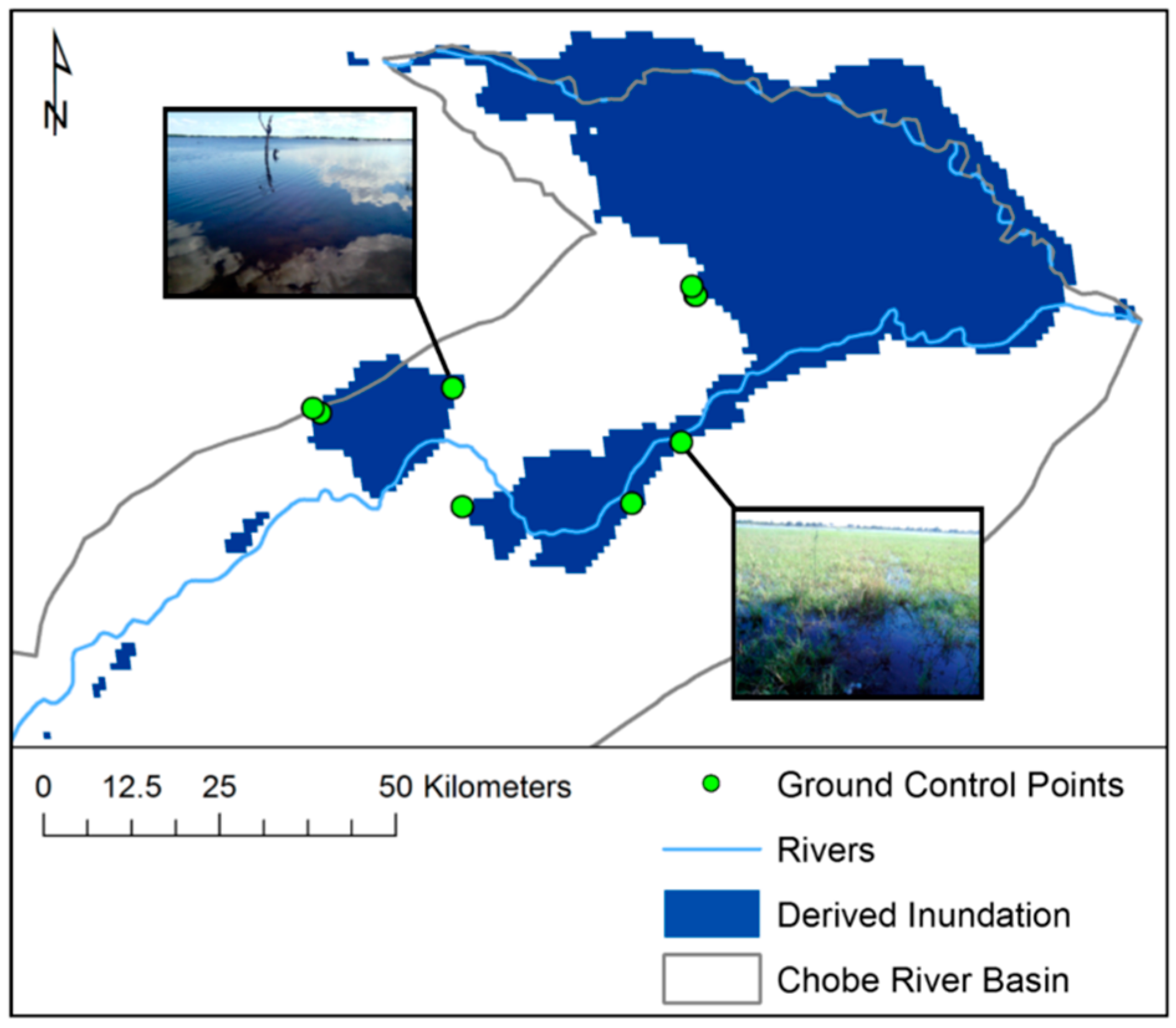
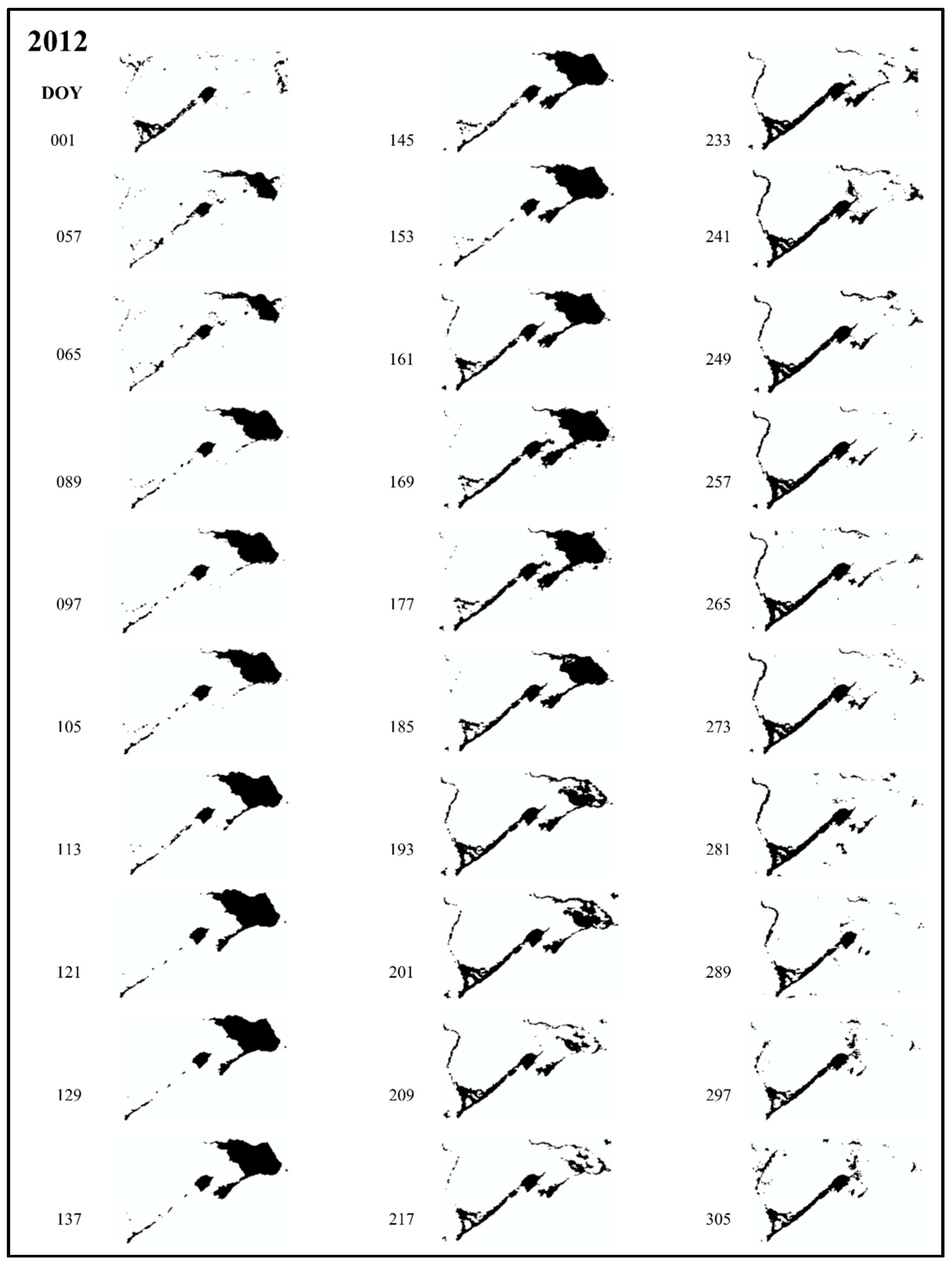


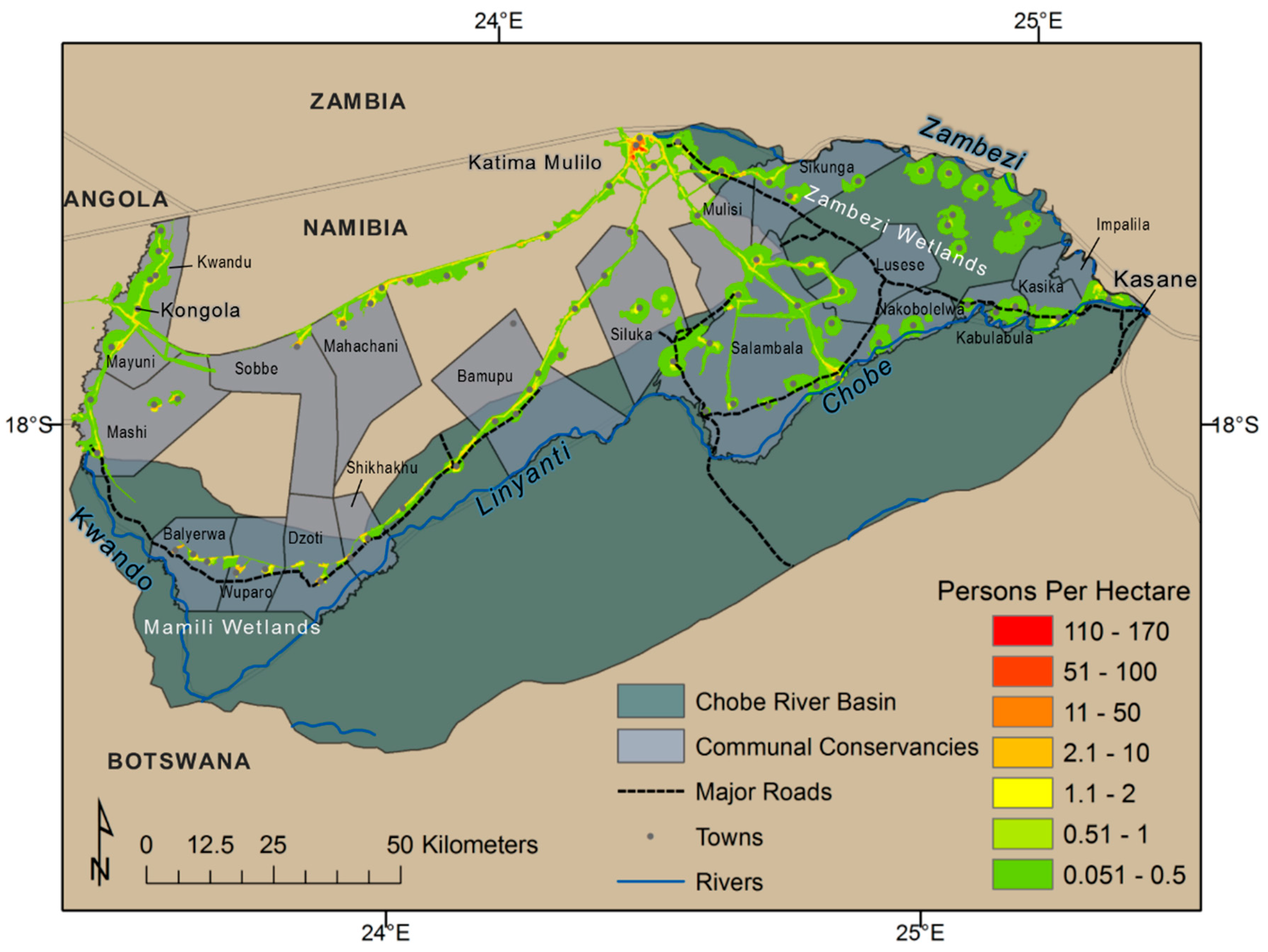
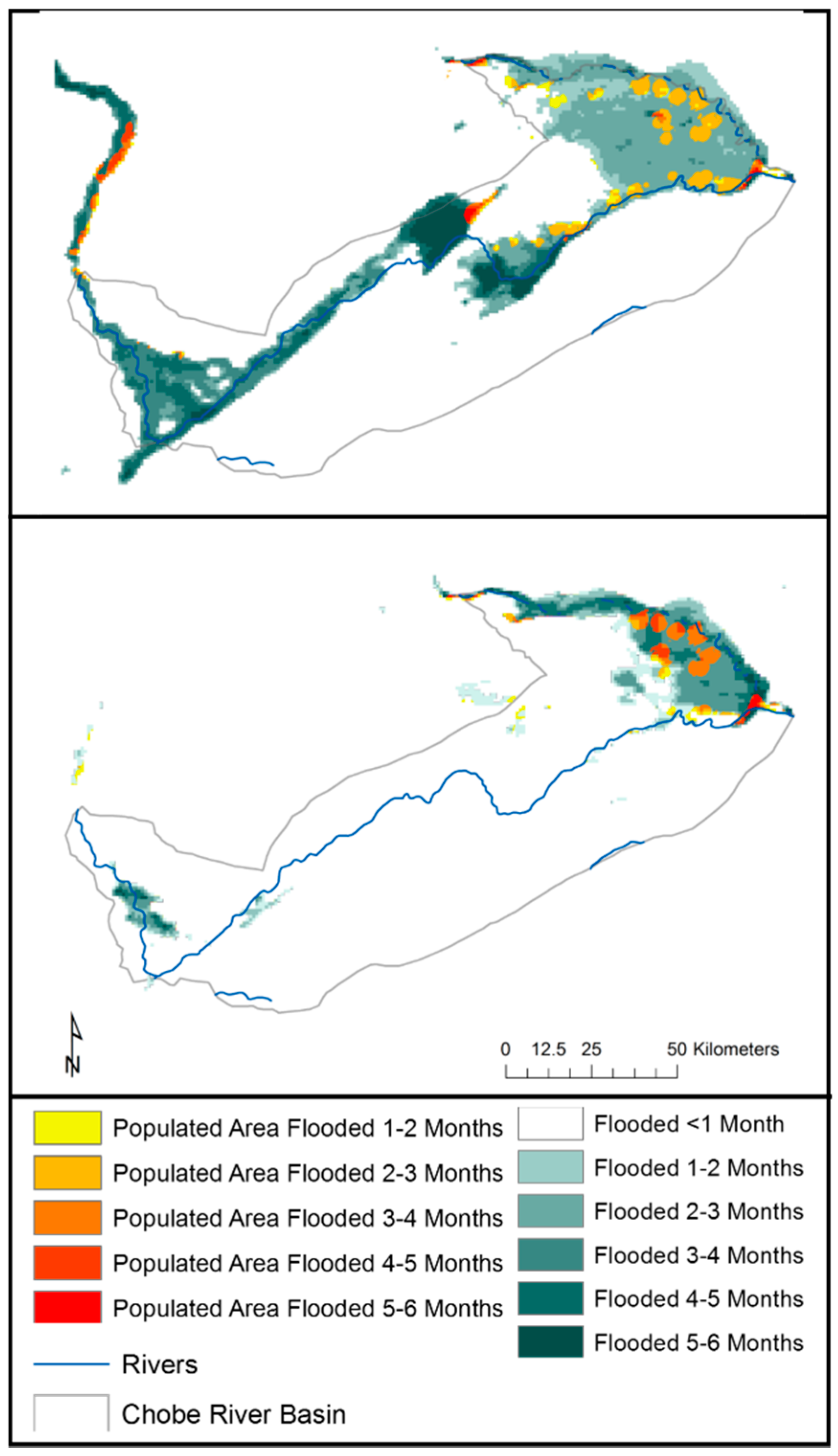

© 2016 by the authors; licensee MDPI, Basel, Switzerland. This article is an open access article distributed under the terms and conditions of the Creative Commons Attribution (CC-BY) license (http://creativecommons.org/licenses/by/4.0/).
Share and Cite
Burke, J.J.; Pricope, N.G.; Blum, J. Thermal Imagery-Derived Surface Inundation Modeling to Assess Flood Risk in a Flood-Pulsed Savannah Watershed in Botswana and Namibia. Remote Sens. 2016, 8, 676. https://doi.org/10.3390/rs8080676
Burke JJ, Pricope NG, Blum J. Thermal Imagery-Derived Surface Inundation Modeling to Assess Flood Risk in a Flood-Pulsed Savannah Watershed in Botswana and Namibia. Remote Sensing. 2016; 8(8):676. https://doi.org/10.3390/rs8080676
Chicago/Turabian StyleBurke, Jeri J., Narcisa G. Pricope, and James Blum. 2016. "Thermal Imagery-Derived Surface Inundation Modeling to Assess Flood Risk in a Flood-Pulsed Savannah Watershed in Botswana and Namibia" Remote Sensing 8, no. 8: 676. https://doi.org/10.3390/rs8080676
APA StyleBurke, J. J., Pricope, N. G., & Blum, J. (2016). Thermal Imagery-Derived Surface Inundation Modeling to Assess Flood Risk in a Flood-Pulsed Savannah Watershed in Botswana and Namibia. Remote Sensing, 8(8), 676. https://doi.org/10.3390/rs8080676






